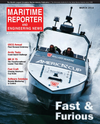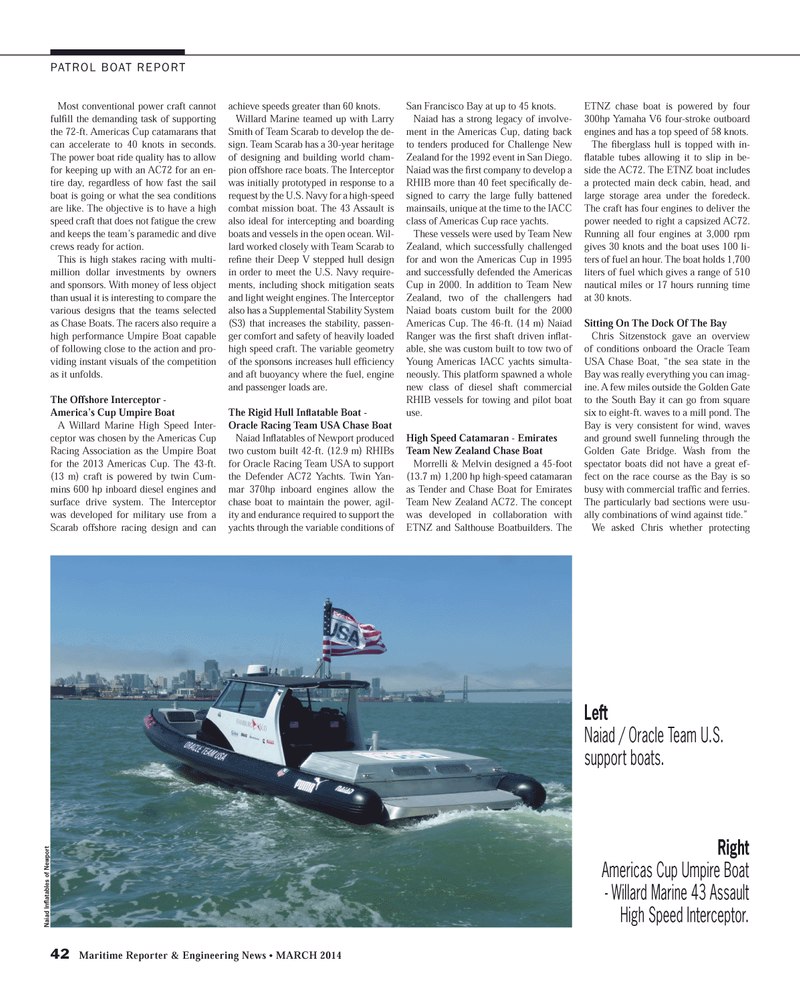
Page 42: of Maritime Reporter Magazine (March 2014)
U.S. Coast Guard Annual
Read this page in Pdf, Flash or Html5 edition of March 2014 Maritime Reporter Magazine
42 Maritime Reporter & Engineering News • MARCH 2014
Most conventional power craft cannot fulfi ll the demanding task of supporting the 72-ft. Americas Cup catamarans that can accelerate to 40 knots in seconds.
The power boat ride quality has to allow for keeping up with an AC72 for an en- tire day, regardless of how fast the sail boat is going or what the sea conditions are like. The objective is to have a high speed craft that does not fatigue the crew and keeps the team’s paramedic and dive crews ready for action.
This is high stakes racing with multi- million dollar investments by owners and sponsors. With money of less object than usual it is interesting to compare the various designs that the teams selected as Chase Boats. The racers also require a high performance Umpire Boat capable of following close to the action and pro- viding instant visuals of the competition as it unfolds.
The Offshore Interceptor -
America’s Cup Umpire Boat
A Willard Marine High Speed Inter- ceptor was chosen by the Americas Cup
Racing Association as the Umpire Boat for the 2013 Americas Cup. The 43-ft. (13 m) craft is powered by twin Cum- mins 600 hp inboard diesel engines and surface drive system. The Interceptor was developed for military use from a
Scarab offshore racing design and can achieve speeds greater than 60 knots.
Willard Marine teamed up with Larry
Smith of Team Scarab to develop the de- sign. Team Scarab has a 30-year heritage of designing and building world cham- pion offshore race boats. The Interceptor was initially prototyped in response to a request by the U.S. Navy for a high-speed combat mission boat. The 43 Assault is also ideal for intercepting and boarding boats and vessels in the open ocean. Wil- lard worked closely with Team Scarab to refi ne their Deep V stepped hull design in order to meet the U.S. Navy require- ments, including shock mitigation seats and light weight engines. The Interceptor also has a Supplemental Stability System (S3) that increases the stability, passen- ger comfort and safety of heavily loaded high speed craft. The variable geometry of the sponsons increases hull effi ciency and aft buoyancy where the fuel, engine and passenger loads are.
The Rigid Hull Infl atable Boat -
Oracle Racing Team USA Chase Boat
Naiad Infl atables of Newport produced two custom built 42-ft. (12.9 m) RHIBs for Oracle Racing Team USA to support the Defender AC72 Yachts. Twin Yan- mar 370hp inboard engines allow the chase boat to maintain the power, agil- ity and endurance required to support the yachts through the variable conditions of
San Francisco Bay at up to 45 knots.
Naiad has a strong legacy of involve- ment in the Americas Cup, dating back to tenders produced for Challenge New
Zealand for the 1992 event in San Diego.
Naiad was the fi rst company to develop a
RHIB more than 40 feet specifi cally de- signed to carry the large fully battened mainsails, unique at the time to the IACC class of Americas Cup race yachts.
These vessels were used by Team New
Zealand, which successfully challenged for and won the Americas Cup in 1995 and successfully defended the Americas
Cup in 2000. In addition to Team New
Zealand, two of the challengers had
Naiad boats custom built for the 2000
Americas Cup. The 46-ft. (14 m) Naiad
Ranger was the fi rst shaft driven infl at- able, she was custom built to tow two of
Young Americas IACC yachts simulta- neously. This platform spawned a whole new class of diesel shaft commercial
RHIB vessels for towing and pilot boat use.
High Speed Catamaran - Emirates
Team New Zealand Chase Boat
Morrelli & Melvin designed a 45-foot (13.7 m) 1,200 hp high-speed catamaran as Tender and Chase Boat for Emirates
Team New Zealand AC72. The concept was developed in collaboration with
ETNZ and Salthouse Boatbuilders. The
ETNZ chase boat is powered by four 300hp Yamaha V6 four-stroke outboard engines and has a top speed of 58 knots.
The fi berglass hull is topped with in- fl atable tubes allowing it to slip in be- side the AC72. The ETNZ boat includes a protected main deck cabin, head, and large storage area under the foredeck.
The craft has four engines to deliver the power needed to right a capsized AC72.
Running all four engines at 3,000 rpm gives 30 knots and the boat uses 100 li- ters of fuel an hour. The boat holds 1,700 liters of fuel which gives a range of 510 nautical miles or 17 hours running time at 30 knots.
Sitting On The Dock Of The Bay
Chris Sitzenstock gave an overview of conditions onboard the Oracle Team
USA Chase Boat, “the sea state in the
Bay was really everything you can imag- ine. A few miles outside the Golden Gate to the South Bay it can go from square six to eight-ft. waves to a mill pond. The
Bay is very consistent for wind, waves and ground swell funneling through the
Golden Gate Bridge. Wash from the spectator boats did not have a great ef- fect on the race course as the Bay is so busy with commercial traffi c and ferries.
The particularly bad sections were usu- ally combinations of wind against tide.”
We asked Chris whether protecting
PATROL BOAT REPORT
Left
Naiad / Oracle Team U.S. support boats.
Right
Americas Cup Umpire Boat - Willard Marine 43 Assault
High Speed Interceptor.
Naiad Infl atables of Newpor t
MR #3 (42-49).indd 42 3/4/2014 11:26:33 AM

 41
41

 43
43
